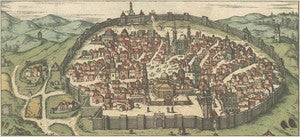
Georg Braun, Frans Hogenberg
from Civitates Orbis Terrarum
c. 1600-23
In Braun and Hogenberg's Civitates Orbis Terrarum, the city of Jerusalem is surrounded by a closed wall that exists to this day. It was ordered by Suleiman the Magnificent and took some four years to build. Viewing from the east, the building at the forefront is the Dome of the Rock (14), built on the Temple Mount, one of the most venerated sites in the Abrahamic religions. Initially constructed in 691, it was rebuilt in 1023 after the original collapsed.


Many of the Christian sanctuaries of Jerusalem are located on the Via Dolorosa, Latin for “Way of Suffering.” This kilometer long stretch was the path Jesus took on his way to his execution. It begins at the Lion’s Gate (41), passes the Pool of Bethesda (18), to the place where Jesus was flogged by the Roman soldiers. The road continues to Pontius Pilate’s house (24) and ends at the Church of the Holy Sepulchre (15). The history of the church dates back to the time of Constantine. Between 326-335, he erected a dome structure that was destroyed by Sultan Hakin in 1009. In 1342, the church was rebuilt in a medieval style. Finally, it was renovated to the baroque-style church of today in 1555.
Some other buildings of note include the prison where John the Baptist was beheaded (28) and the residence of Herod (25). On the southern side of the city is the walled Golden Gate (13) and to the left of that is the court where Peter denied the Lord three times (30).
by Hoon Kang, Map and Geospatial Hub student employee